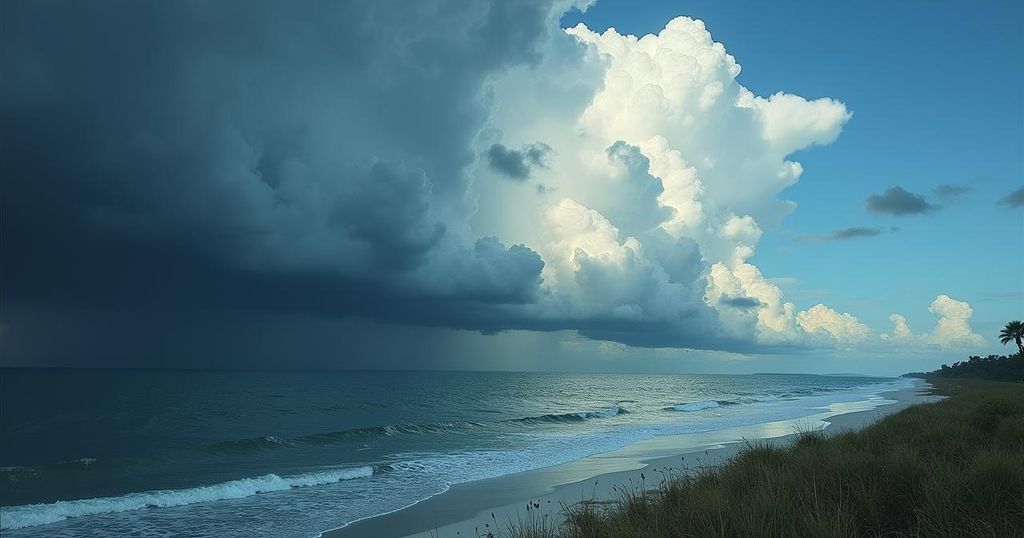Hurricane Milton Threatens Destruction in Florida

Hurricane Milton struck near Siesta Key, Florida, on October 9, 2024, with maximum winds of 120 mph. A state of emergency was declared, prompting mass evacuations. The storm is expected to cause significant damage, with potential record storm surges and flooding. This hurricane exemplifies the increasing intensity of storms related to climate change, as noted by experts who link it to environmental influences.
Hurricane Milton made landfall on October 9, 2024, at 8:30 PM EDT, near Siesta Key along Florida’s west coast, registering maximum sustained winds of 120 mph (193 km/h) as reported by the U.S. National Hurricane Center. Prior to the storm’s arrival, the Florida governor’s office announced a state of emergency across affected regions, resulting in mass evacuations. The NHC indicated that “Milton has the potential to be one of the most destructive hurricanes on record for west-central Florida,” urging residents to swiftly finalize preparations for life and property protection, especially considering the risk of prolonged power outages. Previously classified as a Category 5 storm while over the Gulf of Mexico, Milton fluctuated between Category 4 and Category 5 through its rapid intensification phases since October 7. This intensification was largely attributed to the exceptionally warm waters of the Gulf of Mexico, which provide additional fuel for hurricane development, contingent upon favorable atmospheric conditions such as low wind shear. A forecasted storm surge of up to 10 feet (3 meters) is anticipated along parts of the west-central Florida coast. The NHC warned of severe hurricane-force winds, heavy rainfall, and the likelihood of catastrophic flash flooding. Hurricane Milton’s extensive winds extend up to 30 miles (45 km) from its center, with tropical-storm-force winds reaching as far as 80 miles (130 km). Currently, there are three hurricanes in the Atlantic: Milton, Leslie, and Kirk, which is an unusual occurrence for October. Kirk weakened to an ex-tropical cyclone on October 9 after impacting Europe, particularly affecting France with wind gusts forecasted to reach 110 km/h along the coast. Regarding the broader implications of climate change, a group from World Weather Attribution determined that global warming is significantly influencing the severity of hurricanes. Their research revealed that climate change has led to 10% heavier rainfall associated with hurricanes like Helene, with future rainfall events projected to increase by 15-25% if fossil fuel emissions continue driving global temperatures beyond 2 °C over pre-industrial levels. This underscores the growing evidence that Atlantic tropical cyclones are becoming both wetter and more prone to rapid intensification. In conclusion, the swift approach of Hurricane Milton, coupled with the potential for severe destruction, serves as a stark reminder of the need for preparedness and the ever-increasing influence of climate change on hurricane dynamics.
The occurrence of Hurricane Milton alongside additional hurricanes in October highlights the changing climate and the increasing intensity of storms. The current hurricane season is marked by advanced warm ocean temperatures which prime the atmosphere for the development of powerful hurricanes. Recent studies underscore the impacts of climate change on hurricane intensities, linking it to exacerbated rainfall and rapid intensification phenomena observed in recent storms, including Hurricanes Helene and Beryl. Such knowledge adds urgency to discussions regarding disaster preparedness and risk mitigation in vulnerable areas.
Hurricane Milton’s landfall marks a significant episode in the ongoing Atlantic hurricane season, with potential records in destruction and intensity. Government and meteorological agencies emphasize the necessity of extensive preparations as the frequency and severity of hurricanes appear to be increasingly influenced by climate change. The linkage between environmental factors and storm intensities presents a pressing need for both individual and infrastructural readiness as communities brace against the threats posed by such weather phenomena.
Original Source: wmo.int







